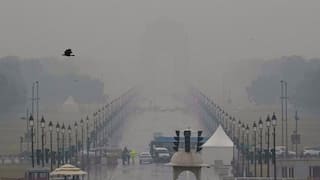Delhi-NCR's Average AQI Worsens As Stubble Burning Continues In Different States: Know The Data
Delhi's air quality neared the "severe" zone amid adverse meteorological conditions and stubble-burning incidents in neighbouring states such as Punjab and Haryana. Know the data pertaining to it.

New Delhi: The National Capital Region every year battles air pollution at alarming levels as a combination of environmental factors and stubble burning cause deterioration in air quality.
On Saturday morning, Delhi's air quality neared the "severe" zone amid adverse meteorological conditions such as low temperatures and calm winds along with stubble burning in Punjab and Haryana among other neighbouring states.
ALSO READ | Will Anti-Smog Guns Help In Curbing Pollution In Delhi? Here's All You Need To Know
The overall Air Quality Index (AQI) of Delhi stood at 396 at 10 am, worsening from 357 at 4 pm on Friday. It was 354 on Thursday, 271 on Wednesday, 302 on Tuesday, and 312 on Monday (Diwali).
Anand Vihar (AQI 454) was the most polluted place in the capital. Wazirpur (439), Narela (423), Ashok Vihar (428), Vivek Vihar (427), and Jahangirpuri (438) were among the monitoring stations that recorded "severe" air quality, news agency PTI reported.
The air quality in the neighbouring cities of Ghaziabad (381), Noida (392), Greater Noida (398), Gurugram (360), and Faridabad (391) also inched closer to the "severe" category.
Here is a look at the AQI in NCR in the past ten days:
|
Date |
Delhi |
Noida |
Ghaziabad |
Gurugram |
Faridabad |
|
October 20 |
232 |
231 |
252 |
189 |
296 |
|
October 21 |
262 |
258 |
300 |
242 |
312 |
|
October 22 |
265 |
290 |
312 |
206 |
280 |
|
October 23 |
259 |
236 |
270 |
251 |
200 |
|
October 24 |
312 |
305 |
300 |
322 |
254 |
|
October 25 |
303 |
299 |
266 |
292 |
289 |
|
October 26 |
271 |
262 |
273 |
244 |
246 |
|
October 27 |
354 |
354 |
373 |
362 |
315 |
|
October 28 |
357 |
371 |
384 |
333 |
346 |
|
October 29 |
396 |
392 |
381 |
360 |
391 |
Except for Ghaziabad which showed marginal improvement today, the AQI in the other NCR cities is currently at its worst in the span of 10 days. The data can be seen in relation to the stubble-burning incidents with Punjab contributing majorly (77.44%) to the overall instances reported from the neighbouring states.
|
State |
Total Incidents Of Stubble Burning |
Contribution In Percentage |
|
Punjab |
10,214 |
77.44% |
|
Haryana |
1,701 |
12.90% |
|
UP |
632 |
4.79% |
|
Delhi |
5 |
0.04% |
|
Rajasthan |
190 |
1.44% |
|
Madhya Pradesh |
448 |
3.40% |
|
Overall Incidents |
13,190 |
|
Despite the Punjab government's meetings with farmers to address the issue of Paddy straw management, the data shows that stubble-burning incidents in the state have already risen above the previous year, recording a 34% rise. Rajasthan has also reported a rise of 188% in stubble burning already as 190 incidents have been reported so far this year.
On the other hand, Haryana, Uttar Pradesh, and Madhya Pradesh have reported a decline in farm fires this year.
|
States |
Total Incidents Of Stubble Burning |
Total Incidents Of Stubble Burning |
2022 Vs 2021 |
|
|
2022 |
2021 |
Increase In Incidents |
Percentage |
|
|
Punjab |
10,214 |
7,648 |
2,566 |
34% |
|
Haryana |
1,701 |
2,252 |
-551 |
-24% |
|
UP |
632 |
805 |
-173 |
-21% |
|
Delhi |
5 |
0 |
5 |
- |
|
Rajasthan |
190 |
66 |
124 |
188% |
| Madhya Pradesh |
448 |
518 |
-70 |
-14% |
|
Overall Incidents |
13,190 |
11,289 |
1,901 |
17% |
Narrowing in on the farm fires in Punjab, the highest number of incidents have been reported on Friday at 2,067. The lowest count in a five-day period was on October 25 at 181.
- October 28 – 2,067
- October 27– 1,111
- October 26 –1,238
- October 25 – 181
- October 24 – 1,019
However, the worst is not over yet as SAFAR, a forecasting agency under the Union Ministry of Earth Sciences, predicted that the share of stubble burning in Delhi's pollution is likely to increase in the coming days.
The contribution of stubble burning to Delhi's PM2.5 pollution has so far remained low (up to 7 per cent) due to a prolonged rain spell in early October and slow transport-level winds which were not strong enough to carry smoke from farm fires to the national capital.
Last year, the share of farm fires in Delhi's PM 2.5 pollution peaked at 48 per cent on November 7.
Other contributing factors include meteorological conditions such as low temperatures and calm winds as in cold conditions, pollutants are trapped close to the ground because of low mixing height -- the vertical height at which pollutants are suspended in the air.
An AQI between zero and 50 is considered "good", 51 and 100 "satisfactory", 101 and 200 "moderate", 201 and 300 "poor", 301 and 400 "very poor", and 401 and 500 "severe".
(With Agency Inputs)
Trending News
Top Headlines





































